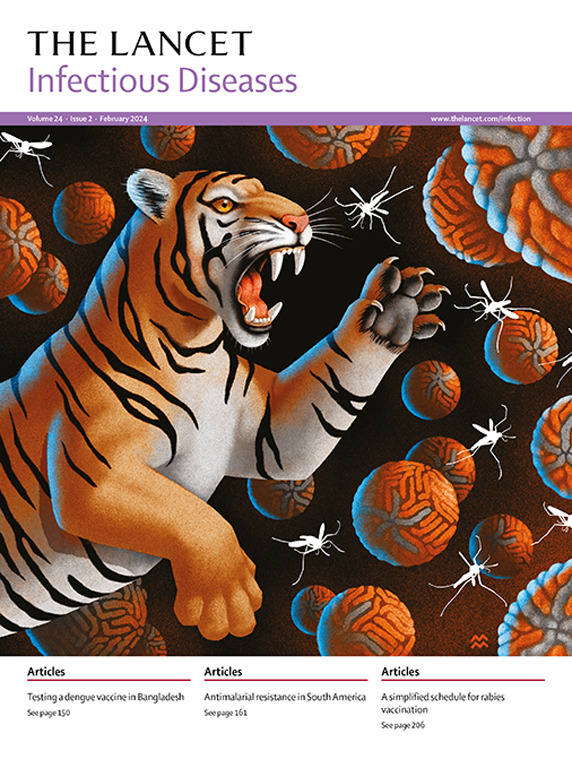Multi-antigen serology and a diagnostic algorithm for the detection of arbovirus infections as novel tools for arbovirus preparedness in southeast Europe (MERMAIDS-ARBO): a prospective observational study
IF 36.4
1区 医学
Q1 INFECTIOUS DISEASES
引用次数: 0
Abstract
Background
Arboviruses are increasingly affecting Europe, partly due to the effects of climate change. This increase in range and impact emphasises the need to improve preparedness for emerging arboviral infections that often co-circulate and might have overlapping clinical syndromes. We aimed to strengthen surveillance networks for four clinically relevant arboviruses in southeast Europe.Methods
This study reports an in-depth analysis of the MERMAIDS-ARBO prospective observational study in adults (ie, aged ≥18 years) hospitalised with an arbovirus-compatible disease syndrome in 21 hospitals in seven countries in southeast Europe over four arbovirus seasons (May 1–Oct 31, 2016–19) to obtain arbovirus prevalence outcomes. The main objectives of the MERMAIDS-ARBO study, describing the clinical management and outcomes of four arboviruses endemic to southeast Europe, including Crimean–Congo haemorrhagic fever virus (CCHFV), tick-borne encephalitis virus (TBEV), Toscana virus, and West Nile virus (WNV), are reported elsewhere. In this analysis, given the challenges associated with arbovirus diagnostics, we developed a diagnostic algorithm accounting for serology outcomes and sample timing to study arbovirus prevalence in southeast Europe. Serum samples were collected on days 0, 7, 28, and 60 after hospital admission and tested for anti-CCHFV IgG and IgM antibodies with ELISAs (confirmed with an indirect immunofluorescence test) and for IgG and IgM antibodies specific to TBEV, Toscana virus, and WNV with custom-printed protein microarrays (confirmed with virus neutralisation tests). All acute-phase samples were tested by PCR for all four viruses. Descriptive analyses were performed for virus-reactive cases by geography and year, and possible factors (eg, age, sex, and insect bites) associated with virus reactivity were assessed.Findings
Of 2896 individuals screened, 913 were eligible for inclusion, of whom 863 (514 men, 332 women, and 17 unknown) had samples sent to the study reference laboratories and were included in molecular and serological analyses. Some individuals had insufficient clinical data to be included in the clinical analysis, but met the eligibility criteria for and were included here. Serum sampling was incomplete (eg, samples missing from one or more timepoints or no data on time since symptom onset) for 602 (70%) patients, and the timing of collection was often heterogeneous after symptom onset up to 40 days (average median delay of 5–6 days across all timepoints), affecting the ability to diagnose arbovirus infection by serology. By use of an interpretation table incorporating timing and completeness of sampling, one (<1%) participant had a confirmed recent infection with CCHFV, ten (1%) with TBEV, 40 (5%) with Toscana virus, and 52 (6%) with WNV. Most acute confirmed infections of Toscana virus were found in Albania (25 [63%] of 40), whereas WNV was primarily identified in Romania (36 [69%] of 52). Albania also had the highest overall Toscana virus seropositivity (168 [60%] of 282), mainly explained by patients confirmed to be exposed or previously exposed (104 [62%] of 168). Patients without antibodies to WNV or Toscana virus were significantly younger than patients with antibodies (mean difference –8·48 years [95% CI –12·31 to –4·64] for WNV, and –6·97 years [–9·59 to –4·35] for Toscana virus). We found higher odds of Toscana virus reactivity in men (odds ratio 1·56 [95% CI 1·15 to 2·11]; p=0·0055), WNV reactivity with mosquito bites versus no mosquito bites (2·47 [1·54 to 3·97]; p=0·0002), and TBEV reactivity with tick bites versus no tick bites (2·21 [1·19 to 4·11]; p=0·018).Interpretation
This study shows that despite incomplete and heterogeneous data, differential diagnosis of suspected arbovirus infections is possible, and the diagnostic interpretation algorithm we propose could potentially be used to strengthen routine diagnostics in clinical settings in areas at risk for arboviral diseases. Our data highlight potential hotspots for arbovirus surveillance and risk factors associated with these particular arbovirus infections.Funding
European Commission and Versatile Emerging infectious disease Observatory.Translations
For the Greek, Albanian, Romanian, Bosnian, Serbian, and Croatian translation of the summary see Supplementary Materials section.求助全文
约1分钟内获得全文
求助全文
来源期刊

Lancet Infectious Diseases
医学-传染病学
CiteScore
60.90
自引率
0.70%
发文量
1064
审稿时长
6-12 weeks
期刊介绍:
The Lancet Infectious Diseases was launched in August, 2001, and is a lively monthly journal of original research, review, opinion, and news covering international issues relevant to clinical infectious diseases specialists worldwide.The infectious diseases journal aims to be a world-leading publication, featuring original research that advocates change or sheds light on clinical practices related to infectious diseases. The journal prioritizes articles with the potential to impact clinical practice or influence perspectives. Content covers a wide range of topics, including anti-infective therapy and immunization, bacterial, viral, fungal, and parasitic infections, emerging infectious diseases, HIV/AIDS, malaria, tuberculosis, mycobacterial infections, infection control, infectious diseases epidemiology, neglected tropical diseases, and travel medicine. Informative reviews on any subject linked to infectious diseases and human health are also welcomed.
 求助内容:
求助内容: 应助结果提醒方式:
应助结果提醒方式:


